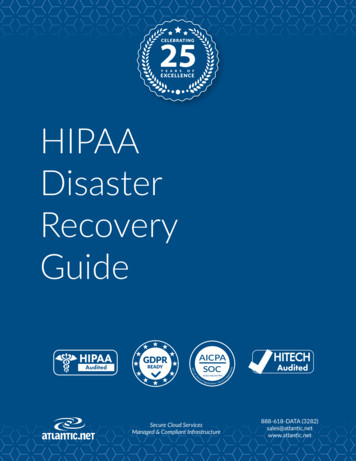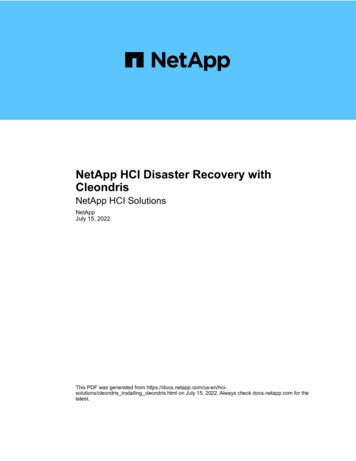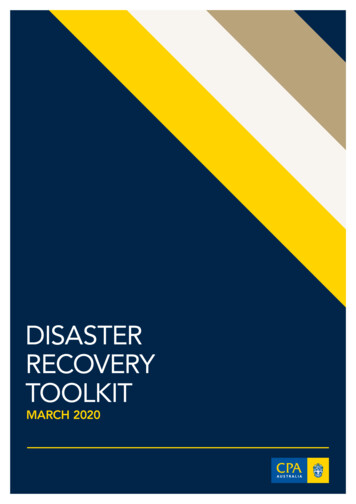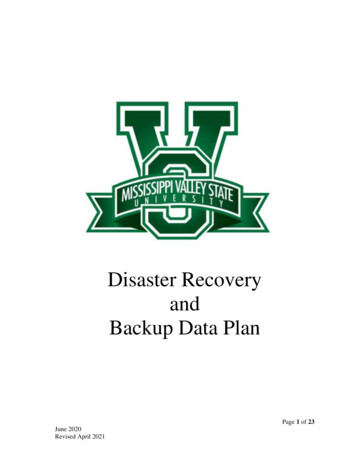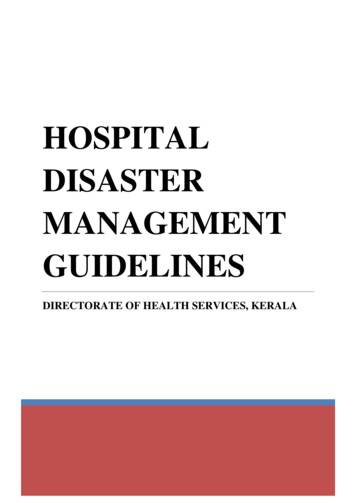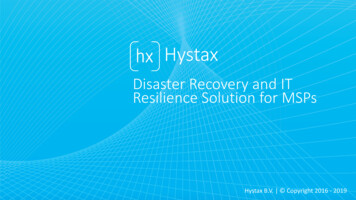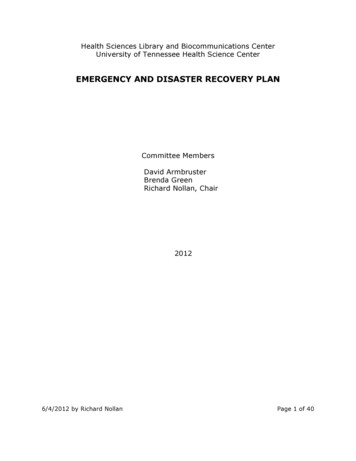
Transcription
Health Sciences Library and Biocommunications CenterUniversity of Tennessee Health Science CenterEMERGENCY AND DISASTER RECOVERY PLANCommittee MembersDavid ArmbrusterBrenda GreenRichard Nollan, Chair20126/4/2012 by Richard NollanPage 1 of 40
Health Sciences Library and Biocommunications CenterUniversity of Tennessee Health Science CenterEMERGENCY AND DISASTER RECOVERY CALL LISTCAMPUS EMERGENCY REPORTING PROCEDURESFor all emergencies involving harm (or possible harm) to people, call theCampus Police at 448-4444. Do not call 911. If needed, 911 will be called bythe Campus Police.For leaking pipes and other minor problems, call the library director’s officeat 448-5694. If no one in library administration is available, call Facilities at448-5661.When reporting any incident, be prepared to state the nature of the incident,its location, and your name. The form can be found on the library’s intranetsite (requires NetID login) at http://intranet.lib.uthsc.edu.LIBRARY ADMINISTRATIONDirectorBusiness ManagerAdministrative Asst.Access ServicesName PhoneTom SingarellaMaggie WhiteBrenda ClarkGwen 6857-1431488-7277DISASTER RECOVERY TEAMRichard NollanBrenda GreenDavid 448-4759448-5051Mobile517-5447240-4450All phone numbers are area code 901 unless otherwise noted.In case of a serious situation that affects collections, call the first person oneach list. If unavailable, leave a message and call the next person on eachlist until someone is contacted. Each person contacted calls the personwhose name is next on the list.Revised 6/4/2012 by Richard NollanPage 2 of 40
Health Sciences Library and Biocommunications CenterUniversity of Tennessee Health Science CenterINTRODUCTIONWhat happens if there is an emergency or disaster in the Health SciencesLibrary? What should people do? How can we protect life? How can we protectthe library and the collection, and how can we provide access to resources andservices in the event of a widespread disaster? These are the questions thatprovided the impetus for the development of this plan: Emergency andDisaster Recovery Plan.This document presents a plan of how to react in the case of an emergency(e.g., crime, water leak, fire) or widespread disaster (e.g., earthquake,tornado) that befalls our facility; as such, it outlines a course or principle ofaction that we have adopted to protect life, the facility, collections, serviceprovision, and access to library services and materials in time of need to ourlibrary patron primary group: UTHSC students, faculty, and staff.Natural disasters cannot be prevented and can happen to any library. But wehope that the severity of a disaster or emergency situation in our library canbe minimized using this recovery plan. Knowing what to do and what not to dobefore, during, and after a disaster can help to prevent panic, lessen theseverity of damage, and enable the library to implement an organized recoveryoperation after the dust settles, the smoke dissipates, or water subsides. Wedefine a disaster as an emergency that has gotten out of control, so weprepare for emergencies, and, if our planning is successful, we will minimizethe disaster effect. The plan aims to minimize the damage incurred during anemergency by providing guidelines for a rapid and effective response to anemergency situation.The disaster plan consists of two sections: Emergency Procedures and DisasterResponse and Recovery Procedures.Many people had input into the disaster plan. We examined other plansthroughout the medical library field to determine best practices. Our disasterplan was developed by a library committee, chaired by Richard Nollan andcharged with developing a document and process that would guide library staffin the event of a disaster.All library staff members should read and have access to this disaster plan.Thomas Singarella, Ph.D.Professor and DirectorHealth Sciences Library and Biocommunications CenterRevised 6/4/2012 by Richard NollanPage 3 of 40
Health Sciences Library and Biocommunications CenterUniversity of Tennessee Health Science CenterPURPOSE OF THE EMERGENCY AND DISASTER RECOVERY PLANUnforeseen crises such as water, smoke, fire, natural disasters, and eventhe possibility of terrorism require emergency preparedness planning.Organized and proactive responses to emergency situations are necessary toprotect employees and clients and to prevent total destruction/loss.This Emergency and Disaster Recovery Plan outlines the key components indisaster preparedness, dealing with disaster prevention, immediate responseactivities, recovery or salvage procedures, and rehabilitation of damagedmaterials. It also contains actions to assist in managing the library’scollection, disaster preparedness strategies, and the roles and functions ofresponse personnel.Copies of this Disaster Plan should be kept both on-site and off-site. Eachmember of the disaster team, as well as the library director and specialcollections librarian, will have a personal copy of the full plan to be kept athome. Department heads will have copies of the plan and will make staffmembers aware of the plan, train them in its use, and discuss with them anyrevisions to it. A current, electronic copy will be on the library’s intranet(intranet.lib.uthsc.edu/).LIBRARY MISSION STATEMENTThe mission of the Health Sciences Library and Biocommunications Center isto provide an environment conducive to student learning and the biomedicalinformation resources necessary for teaching, research, service, and patientcare, and to support efforts to improve the health of Tennesseans.Revised 6/4/2012 by Richard NollanPage 4 of 40
Health Sciences Library and Biocommunications CenterUniversity of Tennessee Health Science CenterTABLE OF CONTENTSEmergency and Disaster Recovery Call ListIntroductionPurpose of the Emergency and Disaster Recovery PlanLibrary Mission Statement2344Emergency ProceduresEmergency Elevator ProcedureLibrary ClosingsViolenceAccidents/Medical EmergenciesFire Emergency ProceduresFire Extinguisher and Fire Alarm LocationsWater Leaks /Internal FloodsLibrary Specific Evacuation ProceduresTornadoTerrorism7788111213141617Disaster Response and RecoveryDisaster Recovery AssignmentsDisaster Recovery ResponseIn-House Emergency SuppliesSalvage PrioritiesSalvage Procedures for Water-Damaged MaterialsInformation TechnologySalvage OptionsMoldRehabilitationDirectory of Consultants, Services, and SuppliesRevised 6/4/2012 by Richard Nollan23242627283233343636Page 5 of 40
Health Sciences Library and Biocommunications CenterUniversity of Tennessee Health Science CenterEMERGENCY PROCEDURESRevised 6/4/2012 by Richard NollanPage 6 of 40
Health Sciences Library and Biocommunications CenterUniversity of Tennessee Health Science CenterELEVATOR EMERGENCY PROCEDURESIn the event someone is trapped in the elevator, talk to the person(s) and tellthem that help is coming. Advise them to use the phone if they find thatreassuring. The phones are connected to Campus Police. Then observe thefollowing procedures:During regular working hoursCall the Campus Police (448-4444) and inform the library director’s office(448-5694). They will contact Facilities Operations. If library administration isnot available, call facilities at 448-5661 for assistance.Tell them someone is trapped in an elevator and that help is neededimmediately.Give them the number and the location of the elevator that is not working: No.57 (public elevator right), No. 58 (public elevator left), No. 59 (internal libraryelevator), and No. 60 (library service elevator).Evenings and weekendsCall the Campus Police at 448-4444 or Facilities Operations at 448-5661.Notify either Gwen Jackson or Maggie White. See Call List (p. 2) for telephonenumbers.LIBRARY CLOSINGSInclement WeatherThe library may close because of weather conditions, such as snow or ice. Ifthis happens, the library will conform to the campus administration’sdecision to close when it is announced. When inclement weather occurs, call901-448-8ICE for more information.Revised 6/4/2012 by Richard NollanPage 7 of 40
Health Sciences Library and Biocommunications CenterUniversity of Tennessee Health Science CenterPower OutagesWhen outages occur during the day, inform library administration or callCampus Police at 448-4444. It is not necessary for library patrons andpersonnel to leave the library. If the outage persists and results in theclosing of the campus, then all patrons must leave.If the outage occurs during the evening or weekend hours, call GwenJackson or Maggie White and contact the Campus Police. If the outage lastsmore than 20 minutes, the library should be closed.VIOLENCEIf suspicious or offensive behavior is observed, ask a supervisor or anotherstaff member to help evaluate the situation.If emergency intervention is required, report the incident to Campus Police at448-4444. Give your name. State if it is an emergency. Explain the nature ofthe problem and your exact location. Answer all questions before hanging up,unless you must move to protect your life.Do not attempt to detain the person yourself.Note: You should report ALL incidents or threats. In each event, complete andturn in a library incident report to the director’s office. The form can be foundon the library’s intranet site (requires NetID login) athttp://intranet.lib.uthsc.edu.ACCIDENTS/MEDICAL EMERGENCIESMedical emergencies involve illness or injury to library patrons or library staff.General ProceduresDial Campus Police at 448-4444. Do not call 911.Report location of the person needing assistance.Revised 6/4/2012 by Richard NollanPage 8 of 40
Health Sciences Library and Biocommunications CenterUniversity of Tennessee Health Science CenterState that you have a medical emergency and that an ambulance is needed.The call will be transferred to the responding agency. Be prepared to give abasic description of the nature of the injury or illness.If no ambulance is needed, state injury or medical condition.If trained, begin first aid.Do not move the ill/injured person unless failure to do so would cause furtherinjury AND it is safe to do so.If Campus Police are not on the scene, send someone outside to direct theemergency responders to the location of the medical emergency.Note: Campus Police should be notified of all cases of mental healthcrises (suicide attempts, disorientation, etc.).Injured library staff members who are ambulatory can obtain medicalassistance at the University Health Services (910 Madison, Suite 922) or bycalling 448-5630.In each case, a library incident report should be completed and turned in tothe director’s office. The form can be found on the library’s intranet site(requires NetID login) at http://intranet.lib.uthsc.edu.Staff Certified in CPR and AEDHealth Sciences Library staff, who are currently certified in CPR(cardiopulmonary resuscitation) and AED (automated external defibrillator),include:Wanda Booker-Wadewbookerw@uthsc.edu448-7295Gloria Harrisgharris@uthsc.edu448-5406Mary Williamsmwill108@uthsc.edu448-5154Revised 6/4/2012 by Richard NollanPage 9 of 40
Health Sciences Library and Biocommunications CenterUniversity of Tennessee Health Science CenterCarolyn Polkcpolk@uthsc.edu448-5036Alicia Sandersasanders@uthsc.edu448-5634Delores Johnsondajohnson@uthsc.edu448-5634Brenda Clarkbclark11@uthsc.edu448-5638First Aid and Emergency EquipmentSmall first aid kits are located at the Reference Desk, Circulation Desk,administrative assistant’s office (room 330), and in the administrative closet(room 331). Large cardboard boxes containing such items as gauze sponges,surgipads, elastic bandages, surgical gloves, and scissors, and first aidinstructions are in the library supply room (room 373).In the event that first aid or CPR assistance is needed, call Campus Police forassistance at 448-4444. In an acute emergency, seek help from trainedlibrary patrons. If no assistance is available, do the best you can untilassistance arrives.Revised 6/4/2012 by Richard NollanPage 10 of 40
Health Sciences Library and Biocommunications CenterUniversity of Tennessee Health Science CenterFIRE EMERGENCY PROCEDURESIF YOU DISCOVER FIRE: Keep low.Take short breaths through your nose.If you are able, place a wet towel over your mouth and nose.If blinded by smoke, keep moving—feeling your way as you go.Do not under any circumstances risk your life. Always evacuate whenyou hear the fire alarm or when in doubt.Precautions If Prevented from Exiting Close as many doors as possible between you and the fire.Before opening any door, feel to determine if it is hot. If hot, do notopen! Find another exit. Open any door cautiously. Be prepared toslam the door shut if you feel heat rush in.If smoke can leak around doors and vents, stuff openings with cloth,rugs, drapes, etc. If possible, soak cloth with water.Do not jump from upper floors. Rescue may be only moments away.If trapped in a room, hang something out of the window to attract theattention of emergency personnel.Report All FiresActivate the fire alarm pull station nearest the fire by pulling the lever all theway down.Call Campus Police at 448-4444 and give the exact location of the fire(building, floor, room number), what is burning, and any injuries. Give yourname.REMEMBER, you must report all fires to the Campus Police in addition topulling the fire alarm box.Assist in the evacuation of personnel, if necessary, from the area to a musterarea (predetermined safe location). It is the responsibility of individualdepartments to inform staff as to locations designated as muster areas).Attempt to provide an accounting of all personnel working in the affected area.Revised 6/4/2012 by Richard NollanPage 11 of 40
Health Sciences Library and Biocommunications CenterUniversity of Tennessee Health Science CenterClose the doors as you exit the fire area.Fight small fires with the proper extinguisher only if you are trained to do so.KNOW and understand the limitations of the equipment. DON'T TRY TO BE AHERO!Remain with the Campus Police until an emergency coordinator has receivedall pertinent information as to the nature of the problem.In each case, complete and turn in a library incident report to the director’soffice. The form can be found on the library’s intranet site (requires NetIDlogin) at http://intranet.lib.uthsc.edu.FIRE EXTINGUISHER AND FIRE ALARM LOCATIONSFire alarms are located on all floors by the door to the Southwest emergency exitNortheast emergency exitFire extinguishers are located on all floors: 2nd flooro West wall between the Media Lab and staff office hallwayo East wall of staff office corridor outside Interlibrary Loan Office(room 226)o East wall near Circulation Desko West wall near emergency exit (outside library) 3rd flooro Northwest corner of building, outside director’s office (room 332)o East corridor, outside mail room (room 355)o Kitchen (room 360)o South wall near emergency exitRevised 6/4/2012 by Richard NollanPage 12 of 40
Health Sciences Library and Biocommunications CenterUniversity of Tennessee Health Science Center 4th flooro Southwest corner of building near copy room (room 407)o Southwest corner of stack areao Northwest corner of building (Madison Ave. windows)o Northeast corner of building (Madison Ave. windows)o Southeast corner of building 5th flooro Southwest corner of building near emergency exito Southwest corner of stack area near room 509o Northwest corner of building (Madison Ave. windows)o Northeast corner of building (Madison Ave. windows)o Southeast corner of buildingIN THE EVENT THAT AN EMERGENCY DOOR IS OPENED AND AN ALARMSOUNDS, SLAM THE DOOR SHUT TO DISCONTINUE THE ALARM.WATER LEAKS/INTERNAL FLOODSNonemergency SituationCall the library director’s office at 448-5694. If no one is available in libraryadministration, call Facilities at 448-5661. Report the problem and the exactlocation (building, floor, room).Take any necessary steps to minimize damage using emergency supplies thatare located in the library’s supply closet. Place a bucket under leaking water oruse paper towels to wipe up if feasible.Emergency SituationCall Campus Police at 448-4444. Report the nature and severity of theproblem and the exact location (building, floor, room). Give your name and acallback number.Turn off and unplug all electrical equipment in the affected area.DO NOT STAND IN OR WALK THROUGH WATER THAT MAY BE INCONTACT WITH LIVE WIRES!Revised 6/4/2012 by Richard NollanPage 13 of 40
Health Sciences Library and Biocommunications CenterUniversity of Tennessee Health Science CenterDo not remove affected books from the shelves. Emergency supplies (plasticsheeting, mops, buckets, etc.) are in the library’s supply closet (third floornext to the student break room) or in the maintenance closets located on thesouth end of each floor. See the EMERGENCY SUPPLIES list. For treatment ofwet books, please refer to the DISASTER RECOVERY RESPONSE section.If evacuation is necessary, see LIBRARY EVACUATION PROCEDURES.Evenings and weekends: After calling 448-4444, notify the circulationsupervisor who will contact the Disaster Recovery Team, if necessary, andother appropriate personnel. If the circulation supervisor is unavailable, notifythe director. Home phone numbers are listed on page 2.LIBRARY-SPECIFIC EVACUATION PROCEDURESWhen the library alarm system is activated, several loud beeps will sound.If the library is to be evacuated, suggested wording for the publicannouncement isIt is necessary to evacuate the building at this time. Please takeyour belongings with you and leave immediately, using the nearestexit. [If there is a fire, add “Do not use the elevators.”] You will beadvised when it is safe to re-enter the building.REPEATCirculation Staff ProceduresThe circulation supervisor will check to see if the building is clear, assistedby designated floor monitors (weekdays).Designated Floor MonitorsDuring working hours5th Floor: Rick Fought, Paul Gahn, Robert Mitchell4th Floor: Deborah Taylor, Maggie White3rd Floor: Tom Singarella, David Armbruster, Brenda Clark, Brenda Green2nd Floor: Mary Williams, Lin Wu, Richard NollanRevised 6/4/2012 by Richard NollanPage 14 of 40
Health Sciences Library and Biocommunications CenterUniversity of Tennessee Health Science CenterEvenings and weekends: The staff on evenings and weekends will beresponsible for checking each floor.General Evacuation ProceduresWeek Day StaffEmergency exit stairs are located in the southwest and northeast corners ofthe library. Elevators automatically turn off when alarms are sounding.Personnel responsible for building evacuation will politely ask library patrons toimmediately vacate the building. If patrons will not do so, state that librarypolicy requires that their names be reported to the Campus Police, who willevict them. Students will be reported to their dean. Then request their namesand IDs. If they refuse, call Campus Police and state the room number. Latercomplete the library Incident Report Form. Library administration will reportstudents to their dean. The Incident Report Form can be found on the library’sintranet site (requires NetID login) at http://intranet.lib.uthsc.edu.Supervisors are responsible for making sure all of their staff members areaccounted for at a pre-designated location outside the building. This includesduring fire alarm drills.Do not re-enter the building until the campus police, health and safetyofficer, or the fire marshal gives approval.Evacuation of Persons with DisabilitiesFloor monitors will also be responsible for assisting evacuation of personswith disabilities. In case of fire or power failure, take people in wheelchairsand with other mobility impairments to the south emergency stairwell exits.You are not required to stay with them. Tell them you will report theirlocation and situation to the nearest emergency personnel (fireman, police,EMTs) who will return to evacuate them. Direct emergency personnel asthey arrive to the location of people who need assistance in leaving thebuilding.Once everyone is alerted, leave the building. Don’t take unnecessary risks.People who refuse to leave must take responsibility for their actions.Revised 6/4/2012 by Richard NollanPage 15 of 40
Health Sciences Library and Biocommunications CenterUniversity of Tennessee Health Science CenterEvening and Weekend StaffFollow the procedures above. Notify the circulation supervisor who will callother appropriate personnel. If the circulation supervisor is unavailable,notify the director or the next person on the Disaster Recovery Call List onpage 2.People on duty should follow the Evacuation of Persons with Disabilitiesinstructions on the previous page. Weekend staff members are responsible forchecking the upper floors.Supervisors will account for all personnel in their departments.TORNADOWhen a tornado warning has been announced, all staff and patrons shouldmove to the basement of the Alexander Building and proceed to the tunnelsystem underneath the General Education Building. As soon as the warningannouncement has been made, the circulation staff member scheduled at theCirculation Desk should repeat the announcement over the public addresssystem in case the campus alert was not heard in all parts of the building.Suggested announcement:The University has just issued a campus-wide tornado warning,which applies to all library patrons and staff. Please take yourbelongings with you and go to the basement of the AlexanderBuilding until we are advised that the warning has been cancelled.Once the public address announcement has been made, most staff shouldimmediately proceed to the basement. Office doors should be closed but notlocked. Individuals are designated to check each floor of the building to remindpatrons to go to the basement. It is not necessary to insist that patronsdepart: once alerted, their safety is their own concern.Revised 6/4/2012 by Richard NollanPage 16 of 40
Health Sciences Library and Biocommunications CenterUniversity of Tennessee Health Science CenterDesignated Floor MonitorsDuring working hours5th Floor: Rick Fought, Paul Gahn, Robert Mitchell4th Floor: Deborah Taylor, Maggie White3rd Floor: Tom Singarella, David Armbruster, Brenda Clark, Brenda Green2nd Floor: Mary Williams, Lin Wu, Richard NollanEvenings and weekends: The staff on evenings and weekends will beresponsible for checking each floor.People on duty at the Circulation Desk should go to the basement and notworry about unauthorized exit and entry.Supervisors/coordinators will account for all personnel in their departments.TERRORISMBomb ThreatsTelephone ThreatsMost bomb threats are made by telephone and are directed to a specificbuilding or department. The employee who receives such a call shoulda. Keep the caller on the phone as long as possible. Have someone elseimmediately notify Campus Police. Ask the caller to repeat themessage. If possible, write down every word spoken by the caller.b. Note the date and time of the call and the telephone number that wascalled.c. Ask the following questions:1. When is the bomb going to explode?2. Where is the bomb right now?3. What kind of bomb is it? Dynamite? Black Powder? TNT? Plastic?4. What does it look like?5. How will the device be set off? Timing device? Heat? Chemical?6. Why did you place the bomb?7. Where are you calling from?8. What is your name and telephone number?d. Get a description of the caller’s voice. If possible, includeapproximate age (old or young), sex, accent, and tone of voice.Revised 6/4/2012 by Richard NollanPage 17 of 40
Health Sciences Library and Biocommunications CenterUniversity of Tennessee Health Science Centere. Pay attention to and record any background noises such as motorsrunning, music playing, or any other noise, which may give a clue asto caller’s location.f. Was the voice familiar? If so, who did it sound like?g. Record the time that the caller hung up, and anything else thatappears pertinent.Written ThreatsWhen a threat is written it is important to save all materials, including theenvelope. Notify library administration first, and they will notify campuspolice immediately. If library administration is not available, contact CampusPolice at 448-4444. Try to avoid any unnecessary handling. Every effortshould be made to retain evidence such as fingerprints, writing, paper, orpostal marks.Bomb ExplosionIn a building explosion, clear the library using the evacuation plan. Get outof the building as quickly and calmly as possible. If items are falling off ofbookshelves or from the ceiling, get under a sturdy table or desk.If there is a fire Stay low to the floor and exit the building as quickly as possible. Cover nose and mouth with a wet cloth. When approaching a closed door, use the palm of your hand and forearmto feel the lower, middle, and upper parts of the door. If it is not hot,brace yourself against the door and open it slowly. If it is hot to thetouch, do not open the door--seek an alternate escape route. Heavy smoke and poisonous gases collect first along the ceiling. Staybelow the smoke at all times.If you are trapped in debris Use a flashlight. Stay in your area so that you don't kick up dust. Cover your mouth with ahandkerchief or clothing. Tap on a pipe or wall so that rescuers can hear where you are. Use awhistle if one is available. Shout only as a last resort--shouting can causea person to inhale dangerous amounts of dust. Untrained persons should not attempt to rescue people who are inside acollapsed building. Wait for emergency personnel to arrive.Revised 6/4/2012 by Richard NollanPage 18 of 40
Health Sciences Library and Biocommunications CenterUniversity of Tennessee Health Science CenterChemical AgentsChemical agents are poisonous gases, liquids, or solids that have toxiceffects on people, animals, or plants. Most chemical agents cause seriousinjuries or death. Severity of injuries depends on the type and amount of thechemical agent used and the duration of exposure. Were a chemical agentattack to occur, authorities would instruct citizens to either seek shelterwhere they are and seal the premises or evacuate immediately. Exposure tochemical agents can be fatal. Leaving the shelter to rescue or assist victimscan be a deadly decision. There is no assistance that the untrained can offerthat would likely be of any value to the victims of chemical agents.Biological AgentsBiological agents are organisms or toxins that have illness-producing effectson people, livestock, and crops. Because biological agents cannot necessarilybe detected and may take time to grow and cause a disease, it is almostimpossible to know that a biological attack has occurred. If governmentofficials become aware of a biological attack through an informant orwarning by terrorists, they would most likely instruct citizens to either seekshelter where they are and seal the premises or evacuate immediately. Aperson affected by a biological agent requires the immediate attention ofprofessional medical personnel. Some agents are contagious, and victimsmay need to be quarantined. Also, some medical facilities may not receivevictims for fear of contaminating the hospital population.Note: You should report ALL incidents or threats. In each event, complete andturn in a library incident report to the director’s office. The form can be foundat http://intranet.lib.uthsc.edu.Safe Mail HandlingIdentifying Suspicious Packages and EnvelopesSome characteristics of suspicious packages and envelopes include thefollowing: Inappropriate or unusual labeling Excessive postage Handwritten or poorly typed addresses Misspellings of common wordsRevised 6/4/2012 by Richard NollanPage 19 of 40
Health Sciences Library and Biocommunications CenterUniversity of Tennessee Health Science Center Strange return address or no return addressIncorrect titles or title without a nameNot addressed to a specific personMarked with restrictions, such as “Personal,” “Confidential,” or “Do not xray”Marked with any threatening languagePostmarked from a city or state that does not match the return addressAppearance Powdery substance felt through or appearing on the package orenvelope Oily stains, discolorations, or odor Lopsided or uneven envelope Excessive packaging material such as masking tape or stringOther suspicious signs Excessive weight Ticking sound Protruding wires or aluminum foilIf a package or envelope appears suspicious, DO NOT OPEN.Handling Suspicious Packages or Envelopes Do not shake or empty the contents of any suspicious package orenvelopeDo not carry the package or envelope, show it to others or allow others toexamine itPut the package or envelope down on a stable surface; do not sniff,touch, taste, or look closely at it or at any contents that may have spilledAlert others in the area about the suspicious package or envelopeLeave the area, close any doors, and take actions to prevent others fromentering the areaIf possible, shut off the ventilation systemWASH hands with soap and water to prevent spreading potentiallyinfectious material to face or skinCall Campus Police at 448-4444 and the library director’s officeCreate a list of people who were in the room or area when this suspiciousletter or package was recognized and a list of persons who also may havehandled this package or letterGive this list to local public health authorities, law enforcement officials,and the library director’s officeRevised 6/4/2012 by Richard NollanPage 20 of 40
Health Sciences Library and Biocommunications CenterUniversity of Tennessee Health Science CenterNote: You should report ALL incidents or threats. In each event, complete andturn in a library incident report to the director’s office. The form can be foundon the library’s intranet site (requires NetID login) athttp://intranet.
The disaster plan consists of two sections: Emergency Procedures and Disaster Response and Recovery Procedures. Many people had input into the disaster plan. We examined other plans throughout the medical library field to determine best practices. Our disaster plan was developed by a library committee, chaired by Richard Nollan and


